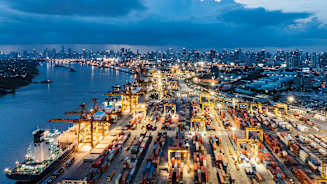Ensuring Operational Stability Post-Spin-Off: A Conversation with Daniel Halter from Sandoz

Daniel Halter, Director Global Insurance at Sandoz, discusses how smart risk and insurance management supported the Sandoz core mission to provide affordable, off-patent medicines to patients who need them most with Ana Serdarevic, Head of Aon’s Transaction Advisory Services for DACH.
Key Takeaways
-
Prioritizing risk management — which includes establishing compliant frameworks and procedures for risk financing and insurance during a carve-out — is crucial.
-
The split from Novartis presented significant challenges, requiring the untangling of integrated processes and frequent adjustments to the insurance risk setup for the new independent entity.
-
Effective communication among internal teams and insurers, including introducing Sandoz to over 80 underwriters and working closely with Novartis’ insurance team, helped ensure a smooth transition.
On October 4th, 2023, Sandoz formally separated from Novartis and began trading on the Swiss Stock Exchange. This strategic decision enabled Sandoz to focus fully on its purpose — pioneering access for patients
— by consistently broadening its offering of affordable, high-quality biosimilars and generics. The separation presented significant challenges, requiring the untangling of integrated processes once shared with Novartis and frequent adjustments to the insurance risk setup for the new independent entity.
Daniel Halter became director of global insurance at Sandoz in April 2023. In this discussion, he covers the vital role of risk and insurance management during Sandoz’s spin-off from Novartis, including strategic considerations, challenges, and solutions for a smooth transition and operational stability. The interview also provides valuable insights into how Sandoz is positioning itself for future growth and innovation in the biosimilars and generics market.
| Company | Headquarters | Traded As | Total Assets |
| Founded in 2022, Sandoz Group AG has a brand history dating back to 1886. | Basel, Switzerland | SIX: SDZ, SMI MID component | $19.430 billion (2023) |
Ana Serdarevic: Can you describe your role and overall experience with the carve-out transaction process?
Daniel Halter: I joined Sandoz to set up compliant risk financing and insurance structures and address specific risk areas. Upon assuming my new role at Sandoz, Aon had already been engaged for several months on the spin-off under Ana Serdarevic’s leadership. The project was set up in a professional and thorough manner, enabling me to quickly understand the tasks and their timelines. My main role is to protect Sandoz’s new balance sheet post-spin-off. This is unlike my previous work, where I adjusted risk structures for private equity companies preparing for the stock exchange and separated fully integrated processes.
Ana Serdarevic: Were there any specific challenges or complexities you faced during the transaction?
Daniel Halter: Sandoz was a fully integrated division of Novartis, with many combined functions that needed to be established for the new company. It’s a moving process, and adjustments are frequent. Therefore, the intended insurance risk setup needs to be adjusted accordingly.
Ana Serdarevic: How did you handle the transition of insurance coverage for the carved-out entity?
Daniel Halter: Initially, we assessed the current insurance policies in place at Sandoz and within the wider group. We compared these policies against identified risks, such as those noted in the IPO prospectus or elaborated internally under our Enterprise Risk Management (ERM) process. Aon assisted by gathering local insurance data from our subsidiaries, including mandatory coverage and best practices. Following our due diligence, we requested quotes for various insurance contracts from the market. A risk financing analysis performed by Aon enabled us to determine the optimal limits and deductible levels based on Sandoz's risk profile and financial status.
Ana Serdarevic: Were there any gaps in coverage during the transition period?
Daniel Halter: Previously, certain risk categories were not covered by insurance, and a captive insurer was used for one line of business. One of the tasks involved isolating Sandoz's exposure within the captive. The strategy for this separation was to replicate existing insurance policies as needed and acquire additional coverage to address identified risks, ensuring that the stand-alone company's risk exposure was properly aligned.
Ana Serdarevic: How did you assess and manage the potential liabilities associated with the carved-out entity?
Daniel Halter: Larger pharmaceutical companies often use risk financing tools, like captives, to cover liability risks. Traditional insurers are usually hesitant to provide significant coverage, especially to new companies. We experienced a lot of willingness to work with Sandoz, but needed to use a variety of different insurers and markets for our insurance program. For Sandoz, gaining insurer trust was crucial, so we involved our senior management in the process and conducted several sessions to show how we manage risks daily. Concerning cyber risks, presenting the stand-alone IT setup and agreements in the transitional service agreements (TSAs) to the insurance market was important.
Ana Serdarevic: What were the financial implications of the carve-out on your corporate insurance costs?
Daniel Halter: As part of Novartis, Sandoz did not bear all insurance costs. After Spin, without a captive insurer, the organization had to cover the premium and insurance premium tax. While we generally secured favorable premium-to-coverage ratios, the total cost of risk influences the margin and insurance premium. We are working toward a thorough understanding of these costs.
Ana Serdarevic: What level of communication did you maintain with insurers during the transaction?
Daniel Halter: Sandoz, a new insurance market account, had previously limited risk information for some business lines, particularly property damage and business interruption (PDBI). We chose to have Aon’s risk engineers visit our top three sites to help evaluate the risks and prepare a risk engineer report, which is distinctive for the Swiss insurance market since these evaluations are usually conducted by insurance companies. During a presentation with over 80 underwriters from all insurance lines and representatives from various insurers, we, alongside our senior team, showcased the independent Sandoz project and its risks. Presentations from finance, operations, legal and supply chain provided firsthand insights and allowed for questions. Subsequent individual discussions with insurers, mostly via Aon brokers, further clarified the company.
Ana Serdarevic: Did you encounter any regulatory or compliance issues related to insurance during the carve-out?
Daniel Halter: Together with Aon and the lead insurers, we adopted a country and business line approach. We assessed where a local policy was meaningful due to compliance reasons or risk exposure. This process included evaluating stand-alone policies, freedom of service options and protection through financial interest clauses (FINC). To meet all legal insurance obligations for both the parent company and the carved-out entity, the separation agreement between the parent company and Sandoz defined liabilities and protections. In most countries, we established individual insurance coverage for Sandoz, while the parent company retained its own.
By designing tailored insurance solutions and fostering seamless collaboration across teams, it is important to help organizations like Sandoz navigate the complexities of separation while setting the foundation for long-term growth and resilience.
Daniel Halter: A lot around communication and a strong understanding of risk and business. Open communication within the organization is vital, detailing the process steps and outcomes and offering necessary training. Sandoz has undergone significant changes throughout this process and continues to evolve. Contacts had to be identified and instructed; and often, these individuals had no prior involvement with insurance matters.
Drawing on my previous successes, I am a firm advocate for the close collaboration between ERM, risk mitigation and risk financing to thoroughly understand risks and devise appropriate management and financing strategies. Insurers share similar interests with the organization: comprehending risks, reducing claims and cutting costs. With precise data and preventive tools, insurers and brokers can actively support the business in mitigating risks and seizing opportunities — regard them as long-term partners, not merely suppliers. For instance, we are currently developing a new biosimilars production facility in Slovenia, where the insurer's risk engineer participates in designing the fire protection system.
Ana Serdarevic: What advice would you give to other companies considering a similar carve-out transaction?
Daniel Halter: Begin by organizing all relevant factors: risks, existing contracts, necessary data and information for setting up coverage, and identifying which internal and external stakeholders can best assist in gathering this information. I strongly recommend collaborating with an insurance broker for such a project. Even if you plan to eventually internalize some functions, a reliable partner is invaluable. For instance, we unexpectedly needed to address coverage gaps through the reinsurance market and less common insurance markets; a broker can facilitate access to these. In over 30 M&A transactions, this was the first time I had such a dedicated project set up on the broker’s side, and it proved to be a significant asset. Lastly, remain adaptable, as changes or adjustments are common.
With precise data and preventive tools, insurers and brokers can actively support the business in mitigating risks and seizing opportunities — regard them as long-term partners, not merely suppliers.
Recommendations for a Smooth Transition
Daniel Halter: During a transaction, early preparation is key. It’s advisable to maintain open communication within the organization, clearly explain the steps and results and offer training where necessary. It is also important to collaborate closely with insurers and brokers to understand risks, reduce claims and costs and gain opportunities. Staying flexible and anticipating potential questions and tasks from the organization is crucial for a successful carve-out.
Ana Serdarevic: Aon has a unique carve-out proposition and can provide innovative solutions using insurance and alternative capital to address gearing constraints and unlock equity upsides. Staffed with a deep bench of specialists capable of deploying multiple “clean teams” in auction processes, Aon has handled over 100 carve-out mandates in EMEA last year alone. Our fully dedicated and multidisciplinary carve-out team supports both buy and sell sides with issues related to risk/insurance, human capital, cyber, intellectual property, credit and litigation.
General Disclaimer
This document is not intended to address any specific situation or to provide legal, regulatory, financial, or other advice. While care has been taken in the production of this document, Aon does not warrant, represent or guarantee the accuracy, adequacy, completeness or fitness for any purpose of the document or any part of it and can accept no liability for any loss incurred in any way by any person who may rely on it. Any recipient shall be responsible for the use to which it puts this document. This document has been compiled using information available to us up to its date of publication and is subject to any qualifications made in the document.
Terms of Use
The contents herein may not be reproduced, reused, reprinted or redistributed without the expressed written consent of Aon, unless otherwise authorized by Aon. To use information contained herein, please write to our team.
Aon's Better Being Podcast
Our Better Being podcast series, hosted by Aon Chief Wellbeing Officer Rachel Fellowes, explores wellbeing strategies and resilience. This season we cover human sustainability, kindness in the workplace, how to measure wellbeing, managing grief and more.
Aon Insights Series Asia
Expert Views on Today's Risk Capital and Human Capital Issues
Aon Insights Series Pacific
Expert Views on Today's Risk Capital and Human Capital Issues
Aon Insights Series UK
Expert Views on Today's Risk Capital and Human Capital Issues
Client Trends 2025
Better Decisions Across Interconnected Risk and People Issues.
Construction and Infrastructure
The construction industry is under pressure from interconnected risks and notable macroeconomic developments. Learn how your organization can benefit from construction insurance and risk management.
Cyber Labs
Stay in the loop on today's most pressing cyber security matters.
Cyber Resilience
Our Cyber Resilience collection gives you access to Aon’s latest insights on the evolving landscape of cyber threats and risk mitigation measures. Reach out to our experts to discuss how to make the right decisions to strengthen your organization’s cyber resilience.
Employee Wellbeing
Our Employee Wellbeing collection gives you access to the latest insights from Aon's human capital team. You can also reach out to the team at any time for assistance with your employee wellbeing needs.
Environmental, Social and Governance Insights
Explore Aon's latest environmental social and governance (ESG) insights.
Q4 2023 Global Insurance Market Insights
Our Global Insurance Market Insights highlight insurance market trends across pricing, capacity, underwriting, limits, deductibles and coverages.
Global Risk Management Survey
Better Decisions Across Interconnected Risk and People Issues.
Regional Results
How do the top risks on business leaders’ minds differ by region and how can these risks be mitigated? Explore the regional results to learn more.
Top 10 Global Risks
Trade, technology, weather and workforce stability are the central forces in today’s risk landscape.
Industry Insights
These industry-specific articles explore the top risks, their underlying drivers and the actions leaders are taking to build resilience.
Human Capital Analytics
Our Human Capital Analytics collection gives you access to the latest insights from Aon's human capital team. Contact us to learn how Aon’s analytics capabilities helps organizations make better workforce decisions.
Human Capital Quarterly Insights Briefs
Read our collection of human capital articles that explore in depth hot topics for HR and risk professionals, including using data and analytics to measure total rewards programs, how HR and finance can better partner and the impact AI will have on the workforce.
Insights for HR
Explore our hand-picked insights for human resources professionals.
Workforce
Our Workforce Collection provides access to the latest insights from Aon’s Human Capital team on topics ranging from health and benefits, retirement and talent practices. You can reach out to our team at any time to learn how we can help address emerging workforce challenges.
Mergers and Acquisitions
Our Mergers and Acquisitions (M&A) collection gives you access to the latest insights from Aon's thought leaders to help dealmakers make better decisions. Explore our latest insights and reach out to the team at any time for assistance with transaction challenges and opportunities.
Natural Resources and Energy Transition
The challenges in adopting renewable energy are changing with technological advancements, increasing market competition and numerous financial support mechanisms. Learn how your organization can benefit from our renewables solutions.
Navigating Volatility
How do businesses navigate their way through new forms of volatility and make decisions that protect and grow their organizations?
Parametric Insurance
Our Parametric Insurance Collection provides ways your organization can benefit from this simple, straightforward and fast-paying risk transfer solution. Reach out to learn how we can help you make better decisions to manage your catastrophe exposures and near-term volatility.
Pay Transparency and Equity
Our Pay Transparency and Equity collection gives you access to the latest insights from Aon's human capital team on topics ranging from pay equity to diversity, equity and inclusion. Contact us to learn how we can help your organization address these issues.
Property Risk Management
Forecasters are predicting an extremely active 2024 Atlantic hurricane season. Take measures to build resilience to mitigate risk for hurricane-prone properties.
Technology
Our Technology Collection provides access to the latest insights from Aon's thought leaders on navigating the evolving risks and opportunities of technology. Reach out to the team to learn how we can help you use technology to make better decisions for the future.
Trade
Our Trade Collection gives you access to the latest insights from Aon's thought leaders on navigating the evolving risks and opportunities for international business. Reach out to our team to understand how to make better decisions around macro trends and why they matter to businesses.
Transaction Solutions Global Claims Study
Better Decisions Across Interconnected Risk and People Issues.
Weather
With a changing climate, organizations in all sectors will need to protect their people and physical assets, reduce their carbon footprint, and invest in new solutions to thrive. Our Weather Collection provides you with critical insights to be prepared.
Workforce Resilience
Our Workforce Resilience collection gives you access to the latest insights from Aon's Human Capital team. You can reach out to the team at any time for questions about how we can assess gaps and help build a more resilience workforce.
More Like This
-

Article 12 mins
Life Sciences at the Crossroads: Innovation, Access and Rising Healthcare Costs
Innovation has always driven growth in life sciences. Yet today, it’s not enough to keep organizations relevant and resilient. As global healthcare changes rapidly, the future of care depends on how well leaders align their breakthroughs with real-world healthcare delivery, affordability and trust.
-

Article 8 mins
Optimizing Your Property Program: 3 Ways Analytics Can Deliver Better Outcomes
Advanced analytics empower forward-thinking risk leaders to secure better terms, anticipate volatility and build resilience. Explore three strategies to future-proof your property program through analytics.































































































































































































